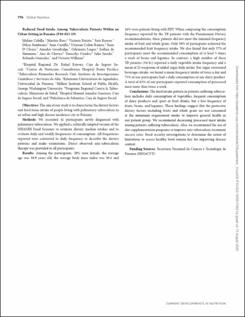Reduced Food Intake Among Tuberculosis Patients Within an Urban Setting in Panama (P10-023-19)
Fecha
2019-06-01Autor
Cubilla, Idalina
Rios, Maritza
Batista, Victoria
Rosero, Sara
Sambrano, Dilcia
Castillo, Juan
Colon-Ramos, Uriyoan
Cleary, Sean D
Goodridge, Amador
Luque, Odemaris
de Simmons, Isolina
de Chavez, Ana
Cuadra, Yaracelys
Jurado, Julio
Gonzalez, Rolando
Williams, Victoria
Metadatos
Mostrar el registro completo del ítemResumen
Objectives The aim of our study is to characterize the dietary factors and food items intake of people living with pulmonary tuberculosis in an urban and high disease incidence city in Panama. Methods We recruited 41 participants newly diagnosed with pulmonary tuberculosis. We applied a culturally adapted version of the NHANES Food Screener to estimate dietary median intakes and to evaluate daily and weekly frequencies of consumption. All frequencies reported were converted to daily frequency to describe the dietary patterns and make estimations. Direct observed anti-tuberculosis therapy was provided to all participants. Results Among the participants, 20% were female, the average age was 38.9 years old, the average body mass index was 20.4 and 16% were patients living with HIV. When comparing the consumption frequency reported by the TB patients with the Panamanian Dietary recommendations, these patients did not meet the minimal frequency intake of fruit and whole grain. Only 30% of participants achieved the recommended fruit frequency intake. We also found that only 37% of participants meet the recommended consumption of at least 3 times a week of beans and legumes. In contrast, a high number of these TB patients (34/41) reported a daily vegetable intake frequency and a mean of 25 teaspoons of added sugar daily intake. For sugar-sweetened beverages intake, we found a mean frequency intake of twice a day and 73% of our participants had a daily consumption of any dairy product. A total of 63% of our participants reported consumption of processed meat more than twice a week. Conclusions The food intake pattern in patients suffering tuberculosis includes daily consumption of vegetables, frequent consumption of dairy products and sport or fruit drinks, but a low frequency of fruits, beans, and legumes. These findings suggest that the protective dietary factors including fruits and whole grain are not consumed at the minimum requirement intake to improve general health in our patient group. We recommend decreasing processed meat intake among patients suffering tuberculosis. Also, we recommend the use of diet supplementation programs to improve anti-tuberculosis treatment success rates. Food security investigations to determine the extent of limitations to access healthy food remain key for improving disease control.

